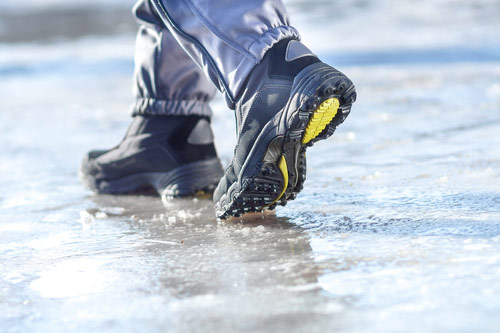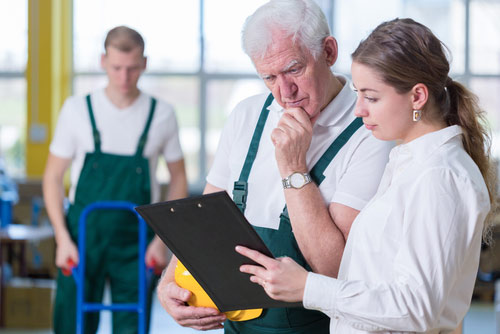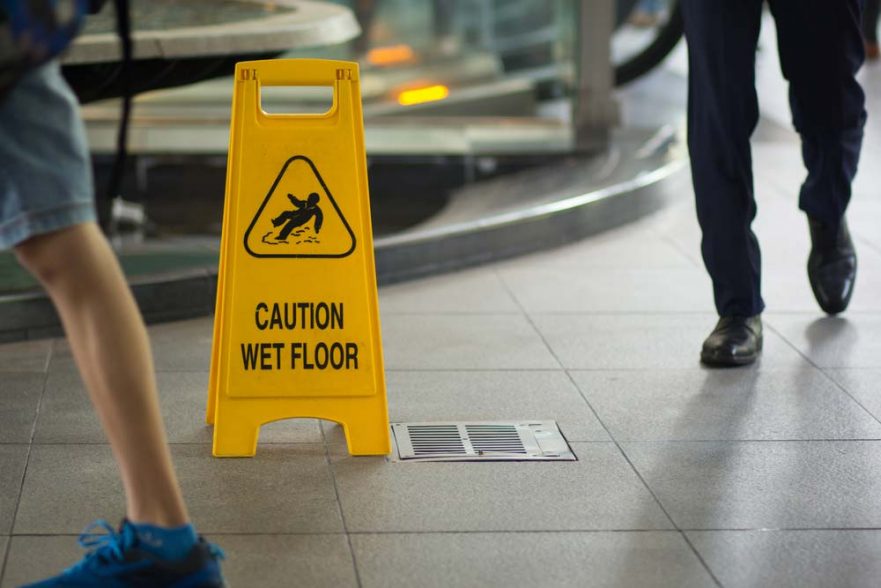Forget what you see on TV – slips, trips and falls are not a joke.
Seeing someone slip and fall on a banana peel in a movie or TV show can be funny, but falling in a store can actually be devastating. Contrary to what movies and television portray, some victims of a slip, trip or fall might not be able to get up and walk away. According to the National Safety Council, falls are the third leading cause of death by unintentional means in the U.S.
Slips, trips and falls in real life

When you are injured on property owned by another person or business entity, lawyers and insurance claims adjusters refer to it as a premises liability case. Slip, trip and fall accidents are a type of premises liability accident in which a person, usually someone visiting an office or retail store, is injured by slipping or tripping due to a dangerous condition of some sort. Common conditions associated with a slips, trips and falls might include:
• Wet floors
• Icy sidewalks
• Torn or loose carpeting or rugs
• Debris
• Cracked, broken, or uneven floor tiles
• Floors that are not level
• Loose or missing handrails on stairways
To get an idea of how common some slip, trip and fall conditions can be, think about the last time you went into a supermarket to shop and walked into the produce section. Stores keep their produce looking fresh by spraying them with water throughout the day. In fact, most supermarkets have automatic systems with sprinklers positioned over the vegetables.
The water and wet leaves that fall from the produce as it is handled by customers ends up on the floor, where it can cause someone to slip and fall. If you were to fall because of either the wet floor or the debris on it, you might have a claim for compensation against the owner of the store.
Proving fault and holding property owners responsible
Business owners are not required to follow you around as you shop in their stores or enter their office buildings to ensure your safety and wellbeing, but this does not mean you assume the risk of falling on a wet floor or tripping over a torn carpet. Owners who invite you and other members of the public to enter their property to conduct business are required to take reasonable steps to ensure your safety.
Business owners have a duty to take steps to remove unsafe or dangerous conditions that could result in a customer having a slip, trip or fall accident. If the floor is wet in the supermarket’s produce aisle, management must take steps to remove the danger by mopping it or at the very least, warning you of it to avoid an accident.
The obligation on the part of business owners to remove dangerous conditions or warn you of them assumes they are aware of the condition. One of the primary elements of any slip, trip and fall-related case is proof that the property owner was aware of the condition and failed to take steps to correct it.
How can you prove notice?

Property owners must know about a condition in order to correct it. Evidence of a written or verbal notice to the owner or manager of a store or business of a dangerous condition is one way to satisfy the notice requirement, but it is not the only way to do so.
Timing is an important factor in slip, trip and fall cases because it can help establish liability when a formal notice has not been given. Business owners are responsible for periodically inspecting their stores and buildings to locate and correct hazards that can cause an accident. The longer a condition exists, the more likely it is that a judge or jury would find that the property owner was negligent in their duty to inspect.
Victims have a duty of care
Victims have a responsibility to proceed with caution when they observe a condition that could cause a slip and fall or trip and fall accident. For example, a woman was injured at a Home Depot when she tripped over the corner of a pallet while shopping. The store claimed that the pallet was obvious and readily apparent to shoppers, so the injured woman should not be able to collect damages for an accident that she could have avoided.
An appellate court rejected the store’s argument and sent the case back to the trial court. According to the appellate court, the facts were such that it would be up to a jury to hear the evidence and decide whether the hazard was as obvious as the store claimed.
If the jury decided that the woman was 10 percent at fault for failing to be observant, the damages to her would be reduced by 10 percent. If the jurors felt the evidence established damages of $100,000, the victim would only receive $90,000.
Negligence on the part of an accident victim in Oregon could reduce the amount of compensation awarded to an injured party because the state follows comparative negligence rules. Comparative negligence means that fault on the part of the victim of any slip and fall or trip and fall accident will not prevent recovery of damages as long as the victim’s fault was not greater than the fault of the property owner. Jurors may, however, reduce the amount of damages they award to the victim by the percentage of that person’s fault.
Only four states, Alabama, Maryland, North Carolina and Virginia, along with the District of Columbia follow a contributory negligence rule that is quite different from comparative negligence. Any negligence, even as little as one percent, on the part of an accident victim precludes a jury from awarding damages to that person. Contributory negligence had, at one time, been the prevailing law in the U.S., but the resulting harsh outcomes caused the shift to comparative negligence in the majority of the states.
Protecting your rights after a slip and fall

If you are the victim of a slip and fall or trip and fall accident, what you do and say immediately after it happens can affect your ability to recover medical costs, lost wages, and other compensation for your injuries. Here are a few tips about what to do if you fall on someone else’s property:
• Do not leave the scene: Slips, trips and falls are embarrassing, so the first thing most people want to do is get up and pretend as though nothing happened. If you are hurt or in pain, stay where you fell, and wait for someone from the store to come to you or call out for help.
• Report the accident right away: Report the accident to a manager or other employee of the establishment. If the report is in writing, get a copy of the report. When making a verbal report, get the name, title, and telephone number of the person to whom you make it.
• Get information about witnesses: If there are other people around when you fall, get their names and contact information.
• Get a picture of the hazard: Use your cellphone to take a picture of the hazard or condition as proof of its existence.
• Watch what you say: Do not admit to any wrongdoing or carelessness on your part, and do not minimize the extent of your injuries. If you are in pain, tell this to the person taking the accident report.
Consulting an attorney
Slips, trips and falls can cause serious injuries, so it is important to report your accident to your attorney as quickly as possible. An attorney might wish to notify the business of your accident and demand that any surveillance videos be preserved and not erased or recorded over.

